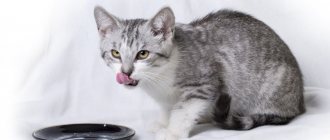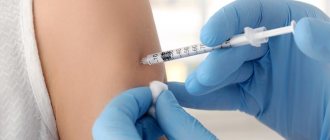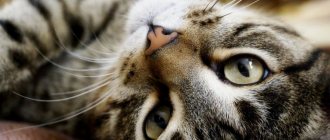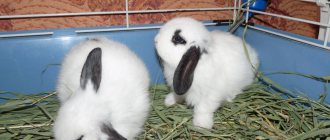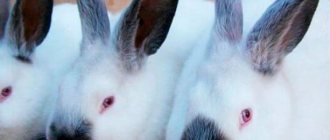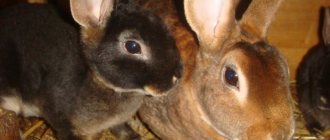Rabbits are one of the species of animals that have very delicate and unstable digestion. As a result, stomach disorders can often be observed in pets. If a rabbit has a swollen belly, a defect called tympany may develop. This disease is considered the most common, so it is very important to promptly identify its development and overcome it. Otherwise, the death of rabbits may begin.
Below we will look in detail at all the causes of bloating. What symptoms will indicate the occurrence of such a problem. How to combat bloat and what you should do regularly as a preventative measure to protect your livestock.
Features of the gastrointestinal tract of rabbits
Like other herbivores, domestic rabbits have a very long digestive system that allows them to extract nutrients from rough plant foods.
The correct operation of the jaw apparatus, consisting of 28 teeth, allows you to thoroughly grind grass, hay, vegetables and grain. Saliva, rich in enzymes, breaks down maltose and starch, after which the food enters the stomach, where it is exposed to hydrochloric acid and other groups of enzymes.
A special feature of the gastrointestinal tract of rabbits is that these animals do not have intestinal smooth muscles, which ensure the pushing of digested food towards the anus.
The movement of food is carried out only due to pressure from the new food consumed by the animal, so even a temporary lack of appetite can lead to intestinal blockage and cause bloating in the rabbit.
Prevention of FSW
Prevention of FSW is proper nutrition of rabbits. They should get the right amount of fiber and water. You also need to give enough vegetables. A good way to prevent constipation and bloating is regular walks, which improve the tone of the intestinal muscles.
The rabbit is a popular farm animal, a source of valuable tasty meat and fur, and in recent years it has also become a common companion animal. For all their advantages, rabbits remain the most vulnerable pets to various diseases, both infectious and other. Gastrointestinal ailments are especially common.
Causes of intestinal blockage and excessive gas formation
When tympania or gastrointestinal stasis occurs, the rabbit's abdomen swells greatly, filling with waste products and gases produced by the body (flatulence).
The animal suddenly loses its appetite and does not drink water, feels depressed, practically does not move and tries to hide in a dark corner of the cage. His stomach rumbles, his breathing quickens, his body temperature drops to 37 degrees Celsius and below, and because of the pain he experiences, the rabbit grinds his teeth a lot.
The main causes of bloating in rabbits are:
- experienced stress, accompanied by prolonged lack of appetite;
- the use of rotted hay and low-quality feed, which contains mold and mildew;
- sudden transition from milk to solid food and from hay to fresh grass;
- lack of movement leading to stagnation of food;
- clogging of the intestines with wool;
- obesity, narrowing the intestinal lumen;
- infection with worms, which activate the release of gases and seething;
- infectious diseases of the oral apparatus.
The cause and treatment of bloating in rabbits are inextricably linked, therefore, first of all, you need to palpate the animal’s abdomen and observe its behavior for several hours.
Symptoms of the disease
Gastrointestinal spasm in rabbits (abdominal upset caused by intestinal blockage) is a common ailment that is not asymptomatic. Experienced farmers easily recognize the disease, but beginners do not always immediately understand what’s going on. To identify ailments, even the simplest knowledge and attention to your furry pet is enough.
- An alarming sign is a change in behavior, the appearance of lethargy and apathy to what is happening around.
- If food-loving rabbits refuse treats, this indicates digestive problems.
- Signs of accumulation of gases or large amounts of food in the intestines are flatulence, gurgling, rumbling in the stomach. At the same time, seals are felt near the walls of the abdomen.
- A swollen abdomen is one of the main symptoms of incipient intestinal tympany in rabbits. Another indicator is problems with stool - the appearance of constipation, which is determined by the absence of droppings for 10 or 12 hours.
- The animal's rapid breathing and increased body temperature (above 37 ℃) should alert you.
The disease develops equally often in both adults and small rabbits, because the causes are related to digestion. Therefore, it is important to monitor the patient’s diet and respond in a timely manner to emerging symptoms.
Find the cause of the problem
When you encounter a similar problem for the first time and are wondering what to do if your rabbit’s stomach is swollen, it is best to immediately seek advice from a veterinarian. An experienced doctor will quickly determine the possible pathology. He will tell you how to treat your pet, suggesting the use of the necessary medications or folk remedies.
Due to the fact that flatulence and tympany are common diseases, certain methods have been developed to treat bloating in rabbits at home.
At the initial stage of the development of the disease, it is impossible to determine the factors that caused it, which may include infectious diseases and the development of worms in the body. Therefore, if a rabbit’s stomach is swollen and begins to growl inside, then it must be urgently separated from other animals by transplanting it into a separate cage.
Be sure to feel your pet's belly. If you feel compaction and transfusion, and also hear rumbling and gurgling sounds, then these are the first signs of a disease that must be treated immediately.
Remember that the development of diseases such as tympany and flatulence occurs rapidly, and within a few hours your pet may die from pain.
The rabbit has a swollen belly - what to do and how to treat it
A safe and simple method of treatment is the use of decoctions and preventive massage. It must be done with smooth finger movements. It is strictly forbidden to press hard, because rabbits have very delicate internal organs. The massage can be either circular or along a line from tail to head. The main purpose of the massage is to help the rabbit so that it can cope with the mass stuck in the stomach and push it through.
The method of treating pets with decoctions is also effective, but it is worth noting that it is more preventative. Decoctions are incapable of coping with acute manifestations of FSW, so you shouldn’t even waste your time on this, because the animal’s life can end at any moment. In order to prepare a decoction, experts advise using dill, chamomile, wormwood and dandelion. For preventive purposes, these components can be mixed into food in dry form.
Important! A sick rabbit needs plenty of fluids and space. Therefore, if possible, he should be allowed out for a walk.
Another remedy that can prevent the fermentation process is alcohol, which can be found in almost every home. To treat adults, you need no more than 2 tablespoons of warm homemade moonshine or vodka, the strength of which does not exceed 30 degrees.
Delaying treatment is dangerous
If you decide to professionally breed rabbits, you should always have medicine on hand to treat bloating in your pets.
The easiest way is to give the animal a laxative enema by injecting no more than 10 ml of warm water mixed with magnesium sulfate and vegetable oil into the anus. To prepare such a mixture, add a tablespoon of magnesium sulfate and a teaspoon of vegetable oil to 500 ml of water.
It is best to use cold-pressed sunflower oil. It is less saturated with fatty acids and has a more gentle effect on the intestinal mucosa.
In most cases, this causes diarrhea and relieves the swollen abdomen of accumulated feces and gases. The animal receives temporary relief, but is not cured of the causes of the disease.
In the early stages of identifying bloating in rabbits, you can give the animal a therapeutic massage, lightly stroking the tummy towards the tail. If the pet begins to squeal in pain and tries to escape, then this procedure must be stopped immediately.
How to properly treat bloating in a rabbit
When detecting signs of an eating disorder, rabbit breeders use the following procedure:
- A sick animal must be separated from other pets ;
- Then, for a thorough examination , the animal should be taken under the front paws and placed with its back on its knees with its head facing you. If the rabbit is nervous or resists, then it must be calmed. As soon as the rabbit gets used to the hands, you can begin to palpate the abdomen and massage.
Abdominal massage for a rabbit
Only after examination, making sure that your pet has bloating, treatment should begin. You can treat it in two ways:
Treatment with folk remedies
The simplest and safest for the animal are massage and decoctions. The massage is done with your fingers , using smooth movements without strong pressure (the internal organs of rabbits are very delicate). The massage can be done either in a circular direction (clockwise) or in the direction from head to tail. The purpose of the massage is to help the rabbit push through the mass stuck in the intestines.
The duration of the massage and repetition frequency are selected empirically. If 5-7 minutes of leisurely massage does not bring relief to the animal, then it is necessary to use more effective means.
Decoctions can also help . However, these remedies are more likely to be preventative. In case of acute manifestations of FSW, decoctions are useless and should not be wasted time on them, especially since the count of the animal’s life can go on for hours.
Rabbit drinks from a bowl
Chamomile, dill, dandelion and wormwood are used to make decoctions. For prevention, these herbs are recommended to be added to food and in dry form.
Another means of inhibiting fermentation in the intestines is available in every home. This is alcohol or its derivatives (vodka or moonshine). For an adult rabbit, you only need 1-2 tablespoons (no more) of a warm drink, the strength of which does not exceed 30 degrees.
A sick rabbit needs plenty of fluids and space. Therefore, if there is an opportunity to let him out for a walk, do not miss it.
In this situation, one person holds the animal tightly by the paws, preventing it from breaking free. Another can carefully open the animal’s mouth and feed it with medicinal mixtures.
Medicines, analgesics, antibiotics
A novice rabbit breeder should be very careful about advice on the use of medications. They can often be useless and sometimes even harmful. However, it is advisable to have a number of medications on hand .
- Activated carbon is a very useful medicine and completely safe. For a sick rabbit, you need to crush 2-3 tablets of coal and stir them in a glass of warm water;
Activated carbon
- Timpanol is a specialized veterinary drug for bloating in ruminants. The dosage is determined based on the weight of the animal. For every kilogram of weight, 0.5 mg of the drug and a tablespoon of warm water are required. The resulting mixture acts for 20-30 minutes. The drug is natural, so its use does not carry any special risks.
It is necessary to refrain from force feeding , all kinds of heating pads, enemas and other means used to treat humans, since they can only be effective in the hands of an experienced rabbit breeder. As for numerous antibiotics and analgesics, it is best to use them after consultation with a veterinarian.
Use of Medicines
Various medications used in human and veterinary medicine are excellent remedies for bloating. Any pharmacy sells Espumisan for children without a prescription, which gives excellent results in the treatment of young animals.
To prevent the baby's tummy from continuing to swell and gurgling, this medicine is instilled directly into the baby rabbit's mouth using a pipette. A single dose of the drug is 20 drops per 1 kg of live weight, and it is given three times a day with an interval of 3 hours.
The use of the drug "Simethicone", which is an analogue of "Espumizan", has also proven itself to be excellent. In addition to the fact that this medicine relieves the rabbit from gas formation and a bloated abdomen, it additionally relieves pain. At the stage of emergency treatment, it can be given 1-2 ml every hour. To avoid an overdose, after alleviating the animal’s suffering, Simethicone is given no more than 3 times a day with an interval of 3 hours.
Treatment of adult animals
Adults can be given "Timpanol", containing tincture of wormwood and hellebore, as well as an antifoam. This is an extremely concentrated medicine used to treat cattle and horses whose bellies become swollen due to overeating. Therefore, you need to be very precise when calculating the dosage for a rabbit.
Typically, 0.4 ml of emulsion is required to be added to 160 g of warm water, after which the resulting solution is thoroughly mixed. Using a pipette, an adult animal is given 1-2 ml of medication no more than 5 times a day. It is not recommended to give this medicine to rabbits.
A reliable way to reduce gas formation and flatulence is the use of activated carbon. The medicine must be crushed and mixed with a small amount of warm water.
The resulting suspension can be given to a rabbit at the rate of 1 tablet of activated carbon per 1 kg of live weight. To avoid constipation, you can use this drug no more than 3 times a day.
If the rabbit's belly is swollen due to intestinal blockage, then the rabbit breeder is faced with dehydration of the pet's body. In this case, to maintain strength, a glucose solution (10 ml per 1 kg of live weight) or a Ringer-Locke solution (the dosage is similar) is injected under the skin.
How to properly treat bloating in a rabbit
If digestive problems are detected, experienced farmers advise adhering to the following system of behavior:
- It is important to place the sick individual separately - this will prevent possible infection of healthy pets.
- The animal is grabbed under the front legs and placed on its back with its head facing you, after which the tummy is palpated and massaged. All manipulations with the rabbit are carried out only after it has calmed down, when the pet stops breaking out of your hands and getting nervous.
- If the abdominal cavity is really swollen, you need to start treatment with traditional or medicinal drugs.
Treatment with folk remedies
The most accessible and harmless methods for the rabbit’s body are drinking herbal decoctions and massaging the tummy.
Decoctions are an easy therapeutic and prophylactic remedy, so in emergency periods when the rabbit needs specialist intervention, this method is not suitable.
Herbs (dandelion, chamomile, dill, wormwood) in dry , crushed form can be added to pets’ food. To stop grumbling and flatulence in rabbits, use vodka (moonshine).
For an adult, no more than 2 tbsp is enough. l., it is important to heat the liquid until warm. The permissible strength of the drink is no higher than 30 degrees.
It is important to provide the baby rabbit with peace, freedom of movement and access to water. If there is an opportunity for the animal to walk nearby, it is recommended to let it out.
Important! A sick pet will not drink medicinal decoctions or alcoholic beverages on its own. You need to take a rubber bulb or a syringe without a needle and pour the liquid into his mouth. It is better to do this together so that the frightened animal does not escape and injure itself.
Massage helps push through the portion of food that has settled in the esophagus. It is performed carefully, gently massaging the tummy area from head to tail or clockwise.
Belly massage for a rabbit
You should not put too much pressure on the peritoneum with your fingers - it would be so easy to cause pain to the animal. If after 5-7 minutes the pet does not feel better, it is worth moving on to more serious treatment measures.
Medicines, analgesics, antibiotics
Not all medications recommended for the treatment of rabbits need to be used in practice. They do not always bring benefit, and sometimes they can only make the situation worse.
However, some drugs must be kept in a veterinary first aid kit:
- Timpanol is a remedy for combating abdominal bloating in ruminants. To determine the dosage, they take into account the weight of the individual: take 0.5 mg of the drug per 1 kg. It is mixed with a tablespoon of warm water and poured into the rabbit's mouth. The effect of the medicine occurs within half an hour. There are no side effects when taking Timpanol.
- Activated carbon is an even safer product. 2-3 crushed tablets are diluted in a glass of warm water and the solution is given to sick individuals.
It is prohibited to give pets enemas, heating pads or other equipment that may seem useful or effective in treatment.
Important! Only a veterinarian is allowed to use them on animals. This also applies to antibiotics and other medications - only a specialist can prescribe them.
Relieve pain symptoms and restore intestinal microflora
Rabbits whose bellies become distended from excessive gas or intestinal blockage are in serious pain, which is why the use of painkillers is recommended.
At an advanced stage of the disease, you cannot do without No-Shpa, which can be administered subcutaneously to a sick rabbit up to 2-3 times a day. To prevent an overdose, first show your sick pet to the veterinarian.
In a number of cases, a specialist based on external signs can determine the infectious causes of the disease and prescribe treatment using antibiotics.
After relieving the symptoms of the disease and eliminating the causes that caused it, you will need to restore the intestinal microflora of your pet. To do this, you will need to supplement your food with probiotics prescribed by your veterinarian.
The body of adult herbivores is not able to digest lactose. This is the main reason why rabbits are strictly prohibited from giving yoghurts and kefir, which can cause even more serious gastrointestinal problems.
Prevention of stasis and bloating
The best prevention of stasis and bloating is an active lifestyle. Allow your animal to run and frolic, do not lock it in a cramped cage without the ability to move.
Also, do not allow yourself to experience strong emotions and stress (a rabbit can be frightened, for example, by another animal, loud screams, fire, etc.).
Table 2.
Approximate diet of female rabbits (grams/day).
| Feed | Physiological state of the female | ||
| Calm | pregnant | nursing | |
| Green food | 800 | 1000 | 1400 |
| Silage | 300 | 200 | 300 |
| Roots | 250 | 200 | 300 |
| Carrot | 300 | 400 | 500 |
| Beet | 300 | 300 | 400 |
| Hay | 200 | 180 | 300 |
| Protein food | 100 | 100 | 150 |
| Cereal grain | 50 | 100 | 150 |
| Legume grain | 40 | 60 | 100 |
| Cabbage leaves | 400 | 500 | 600 |
| Vegetable waste | 200 | 250 | 300 |
| Milk | 10 | 50 | 100 |
| Mineral feed | 3 | 4 | 6 |
Monitor your pet's health: dental condition, mood, appetite, posture in which the animal is at rest. If there are signs of stasis or bloating, be sure to take the temperature (high temperature is a sign of infection and a reason to visit the veterinarian).
Provide access to fiber-rich foods (hay and hard vegetables).
In the videos below, experienced rabbit breeders will talk about the features of feeding their pets in winter and making their own feed:
Video - Features of feeding in winter.
Video - Preparing feed for rabbits.
Use of folk remedies
Many rabbit breeders fundamentally refuse to use medications, preferring to treat flatulence, tympany and gastrointestinal stasis using proven traditional methods.
Ordinary moonshine or alcohol tincture diluted to 30% concentration has excellent anti-inflammatory and fermentation-inhibiting effects. If you pour 1 tablespoon of this liquid into a young animal, gas formation in its body is almost guaranteed to stop. For an adult rabbit, you will need to increase the dose to two tablespoons, although this method should not be abused.
Remember that a higher concentration of alcohol will cause burns to the mucous membranes of the animal’s esophagus and stomach. In rare cases it will end in death.
An infusion of chamomile flowers has excellent antiseptic properties. One tablespoon of crushed flowers is poured into a glass of boiling water and infused for 30 minutes. The cooled infusion is filtered and given to rabbits instead of regular drink. To restore digestive processes, 30-40 ml of chamomile infusion is enough, although in the future it can be used regularly for preventive purposes.
Gastrointestinal stasis
Stasis is a state of the body in which digested food (chyme) and feces do not move through the gastrointestinal tract. Digestion of food thus stops, nutrients stop entering the blood, and various putrefactive bacteria multiply in the chyme, which can penetrate through the intestinal wall into the blood or abdominal cavity, causing sepsis. Therefore, stasis is a potentially life-threatening condition for the animal.
Stasis is usually caused by insufficient intake of food rich in cellulose into the gastrointestinal tract. Because Rabbits have weak peristalsis; only pushing the chyme with new portions of food with fiber can bring the animal out of this state.
Video - Gastrointestinal stasis in a rabbit
Replace water with medicinal infusions and decoctions
A proven way to reduce gas formation and restore the functioning of a rabbit’s gastrointestinal tract is to use infusions of mint or lemon balm, which grow in almost every garden. They are brewed in the same proportion as chamomile. The antiseptics contained in the plants kill pathogenic bacteria, and the presence of menthol relieves pain in the animal.
To increase appetite and improve digestion, rabbits can be given a decoction of oats, which also has anti-inflammatory properties.
To prepare the medicine, take a glass of unpeeled oats (this is very important) and fill it with 1 liter of cold water. The grains should be infused in water for 12 hours, after which the container should be placed on low heat, brought to a boil and boiled for at least half an hour.
Wrap the container removed from the heat in an old blanket and place in a warm place for another 12 hours. Strain the finished broth through a sieve. It can be given to rabbits instead of water at the rate of 40 ml per day.
Prevention of rabbit flatulence
The physical condition of the animal must be constantly monitored in order to promptly notice the onset of the disease.
The quality of feed also needs to be carefully monitored. The diet must be properly balanced. Changing the diet and switching to new types of food should be done gradually. Decoctions of dandelions, wormwood, dill or chamomile improve digestion. Drinking for rabbits should always be fresh, clean and available around the clock. You can add a small amount of lactic acid to the water.
Therapeutic diet for tympany and flatulence
Often the cause of bloating in rabbits is poor nutrition and the use of feed contaminated with microbes and fungi. If you want to keep your pets healthy, then you definitely need to put them on a diet.
In case of flatulence, it is recommended to stop feeding for about 10-12 hours, giving the animals only purified water or chamomile infusion. Then feeding is restored by giving the rabbits fresh hay or oats, to which you can add a little fresh mint or lemon balm. Pumpkin and zucchini are considered excellent dietary food.
For several days, rabbits should absolutely not be given fresh herbs, fruits, as well as cabbage, legumes and beet tops. 3 days after the bloating has passed, the animals can begin to add grated carrots to their food.
The standard course of dietary nutrition is one week, after which a rabbit that has recovered from tympany can be transferred to normal feeding.
What to do with this disease, diet and food
Sick and newly recovered individuals must follow a diet for several days. The optimal period is from 4 days to 1 week. It is worth excluding vegetables, herbs and fruits that can cause upset. Let's eat oats and hay. You can give pumpkin, which is a dietary treat. Parsley, chamomile and sage have a good effect on digestion.
